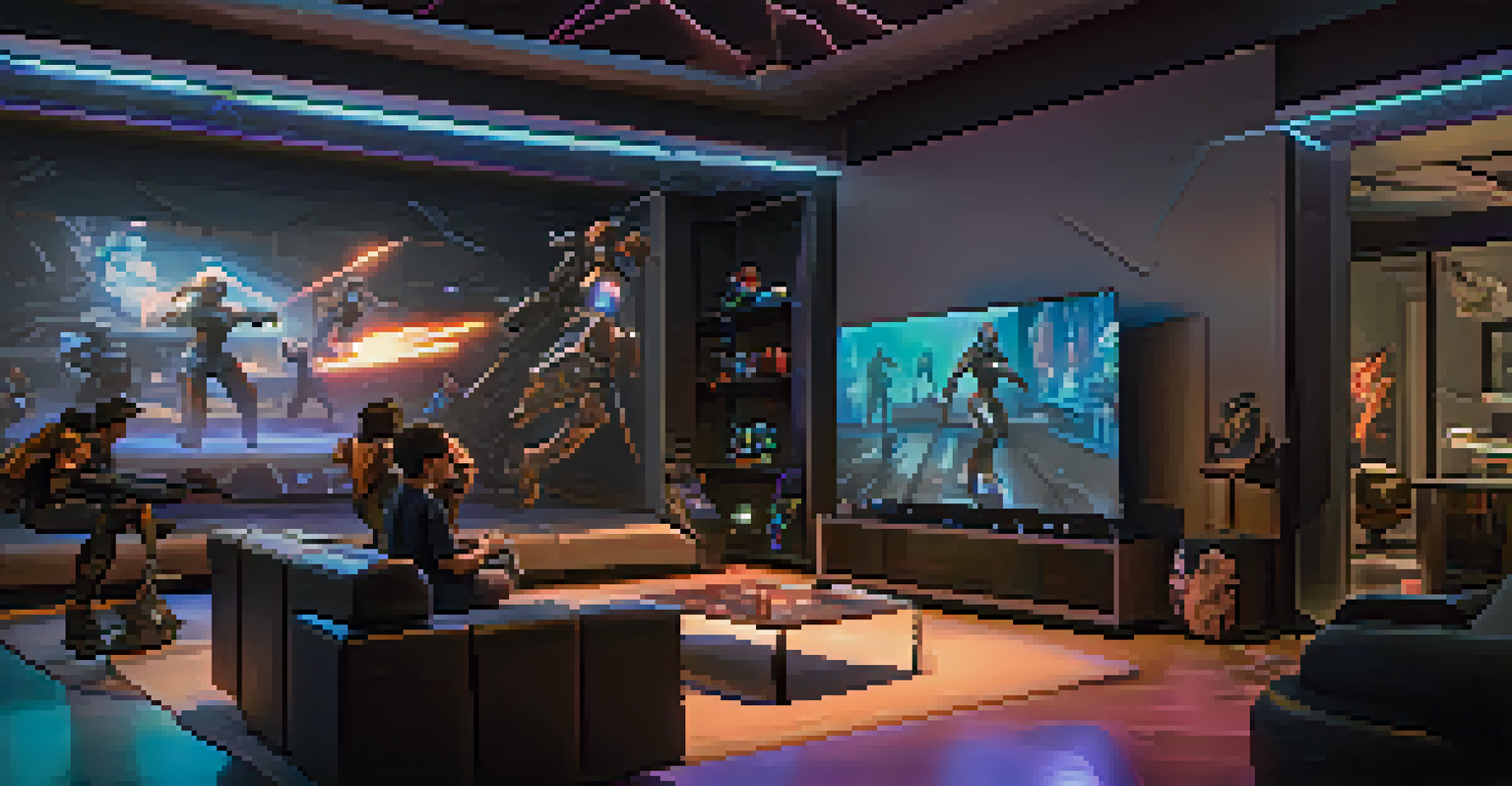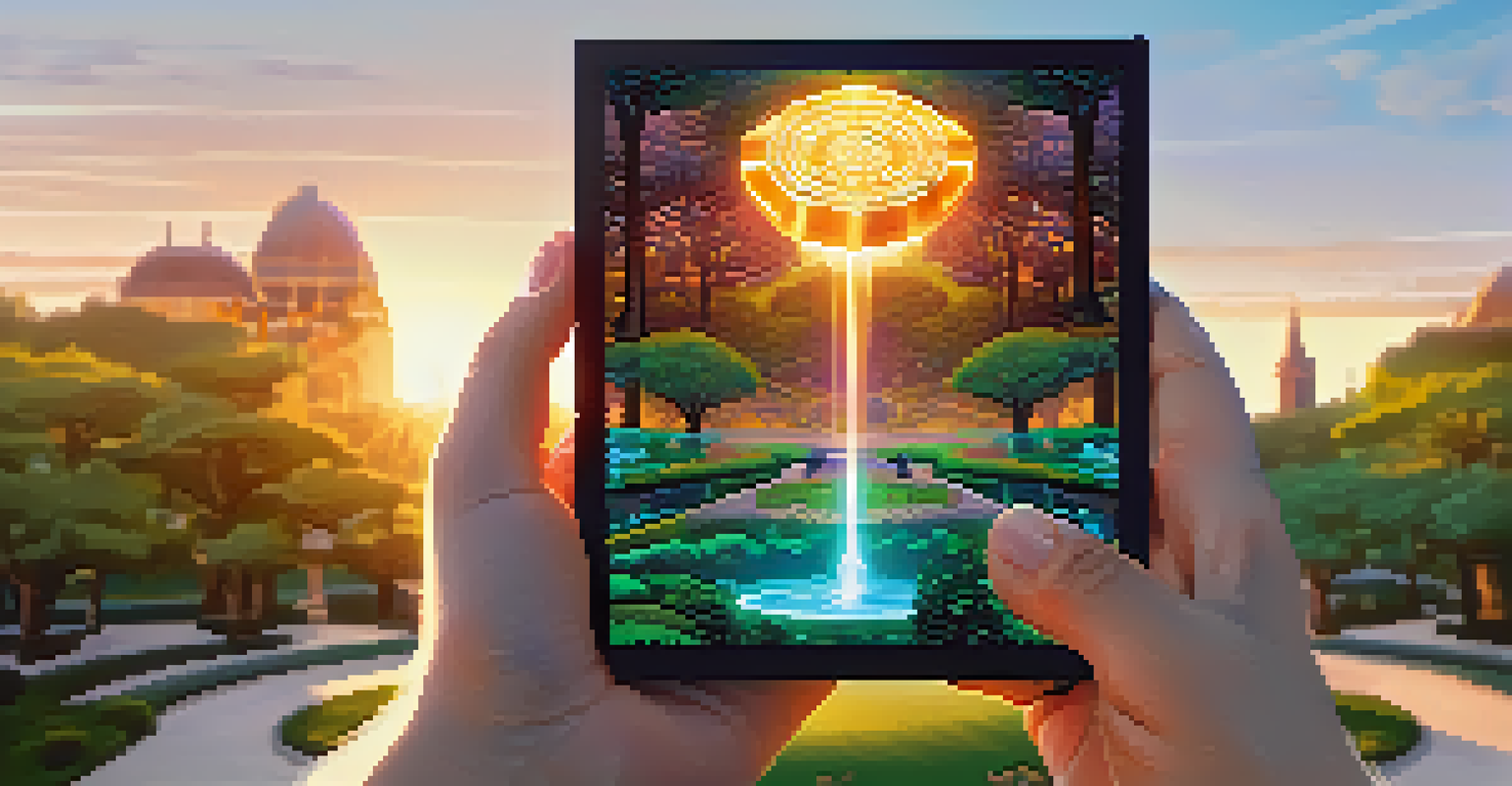Enhancing Gaming Experiences with AR and NFT Integration

Understanding Augmented Reality in Gaming
Augmented Reality (AR) blends the digital and physical worlds, creating immersive gaming experiences. Imagine walking through your neighborhood and seeing virtual monsters pop up, waiting to be caught—this is the magic of AR. By overlaying digital elements onto real-world environments, AR makes gameplay more interactive and engaging. Popular games like Pokémon GO have already demonstrated the potential of AR, attracting millions of players who enjoy a new layer of adventure.
Augmented reality is the bridge between the imaginary and the real world, allowing us to engage with the digital in an entirely new way.
What sets AR apart from traditional gaming is its ability to encourage players to explore their surroundings. Rather than being confined to a screen, gamers are encouraged to venture outside, transforming their local parks or streets into vibrant game boards. This not only enhances the gaming experience but also promotes physical activity, making it a win-win situation for players. Players can experience the thrill of the game while enjoying the benefits of outdoor exploration.
As technology advances, we can only expect AR to become more sophisticated. Imagine a future where your living room transforms into a battle arena, complete with interactive environments and characters. This potential makes AR a game-changer in the industry, paving the way for experiences that feel truly limitless.
The Role of NFTs in Gaming
Non-Fungible Tokens (NFTs) are revolutionizing how we think about ownership in gaming. Unlike traditional in-game items that reset with each new game, NFTs represent unique assets that players can truly own. Picture owning a rare sword or a character skin that you can sell, trade, or showcase—this is what NFTs bring to the table. By leveraging blockchain technology, NFTs ensure that each item is verifiable, giving players confidence in their ownership.

This new model not only empowers players but also opens up new revenue streams for developers. Imagine a gaming ecosystem where players can earn from their skills and creativity, whether by crafting unique items or participating in tournaments. The NFT market is booming, and developers are starting to recognize the potential benefits of incorporating NFTs into their games. This shift is creating a more vibrant and dynamic gaming economy.
AR Enhances Gaming Exploration
Augmented Reality encourages players to explore their real-world environments, making gaming more interactive and physically engaging.
However, while the promise of NFTs is exciting, it also comes with challenges. Issues like environmental concerns related to blockchain technology and the need for user education are critical. As the industry navigates these challenges, the successful integration of NFTs could redefine the gaming landscape for years to come.
Combining AR and NFTs for Unique Experiences
The combination of AR and NFTs presents an exciting opportunity for game developers. Imagine a game where players can find and collect unique NFT items in the real world, enhancing both the gameplay and the value of those assets. For instance, a player might discover a digital artifact hidden in their favorite park, which is not only visually stunning but also has a unique NFT tied to it. This fusion creates a sense of discovery that is simply unmatched.
NFTs have the potential to change the way we think about ownership, creating a future where digital assets are as valuable as physical ones.
Moreover, integrating AR and NFTs can deepen the narrative experience in games. Players could unlock story elements by interacting with AR objects in real life, making the story feel more personal and engaging. This kind of immersive storytelling can lead to a stronger emotional connection between players and the game world, further enhancing the overall experience.
As we explore this integration, we’re likely to see innovative gameplay mechanics emerge. Developers are just scratching the surface of what’s possible, and the future may hold experiences we can't yet imagine. By leveraging both technologies, the gaming industry can create experiences that are not only fun but also deeply meaningful.
Benefits of AR and NFT Integration for Players
Integrating AR and NFTs offers numerous benefits for players, elevating the gaming experience to new heights. First and foremost, players gain a sense of real ownership over their in-game assets, which can lead to increased investment in the game. When players can buy, sell, or trade their unique NFTs, it adds a new layer of strategy and excitement. This feeling of ownership can enhance engagement and encourage players to participate more actively.
Additionally, the combination of AR and NFTs can foster community building among players. Imagine participating in real-world treasure hunts where players collaborate to find unique NFTs. This shared experience can not only strengthen social bonds but also create a vibrant community around the game. Players would no longer be isolated in their gaming experience; they would be part of a larger adventure.
NFTs Redefine Ownership in Gaming
Non-Fungible Tokens allow players to truly own unique in-game assets, transforming the concept of ownership and creating new revenue opportunities.
Finally, the blend of AR and NFTs can enhance the overall enjoyment of gaming. The thrill of discovering something unique in the physical world, combined with the satisfaction of owning a rare digital asset, creates a multifaceted experience. As players engage with both technologies, they may find themselves exploring new ways to play, connect, and enjoy their favorite games.
Challenges in Integrating AR and NFTs
Despite the exciting potential of AR and NFTs, several challenges need to be addressed. One of the most prominent concerns is the technological barrier—players need access to compatible devices and a basic understanding of both AR and NFTs. This can limit the audience, especially among those who might be unfamiliar with new technologies. Game developers must find ways to make these technologies accessible and user-friendly for all players.
Another challenge is the environmental impact of NFTs. The blockchain technology that supports NFTs can consume significant energy, raising concerns about sustainability. As players become more aware of these issues, developers must work diligently to find eco-friendly solutions that do not compromise the gaming experience. Balancing innovation with responsibility will be important in gaining player trust.
Lastly, the legal and regulatory landscape surrounding NFTs is still evolving. Questions of ownership, copyright, and the value of digital assets are complex and can create uncertainty for both players and developers. Navigating these challenges will require collaboration across the industry, ensuring that AR and NFT integration is not only fun but also legally sound.
Future Trends in AR and NFT Gaming
As the gaming industry evolves, we can expect to see exciting trends emerging from the integration of AR and NFTs. One potential trend is the rise of interactive and location-based games that encourage players to explore their environments. This could lead to more AR experiences that are not just about gameplay but also about discovering new places and meeting new people. The blend of exploration and gaming can create memorable experiences that players will cherish.
Another trend could be the development of cross-game interoperability for NFTs. Imagine owning a unique character skin in one game that you can also use in another. This would enhance the value of NFTs and create a more interconnected gaming ecosystem. Players could build their identities across multiple games, fostering a sense of continuity and personalization that has been previously unattainable.
Combining AR and NFTs Creates Depth
The integration of AR and NFTs offers unique gameplay experiences and deeper narrative connections, enriching player engagement.
Finally, as AR and NFT technologies mature, we may see more sophisticated storytelling elements integrated into games. Developers could create rich narratives that respond to players' interactions with both the digital and real worlds. This innovation can lead to a new era of immersive storytelling, where players are not just passive consumers but active participants in shaping the story.
Conclusion: The Future Awaits
The integration of AR and NFTs is poised to redefine the gaming landscape, offering players innovative and immersive experiences. By blending the physical and digital worlds, game developers are crafting adventures that go beyond traditional gameplay. As we continue to explore this exciting frontier, the potential for engaging narratives, ownership, and community will only grow stronger.
However, it's essential to address the challenges that come with this integration, ensuring that the gaming community remains inclusive and sustainable. As both players and developers navigate this journey, collaboration and creativity will be vital in overcoming obstacles and maximizing opportunities. Together, we can shape a gaming future that is not only entertaining but also responsible.

Ultimately, the future of gaming lies in our hands. With AR and NFTs paving the way, we can look forward to a new era of experiences that enrich our lives and connect us in ways we've never imagined. So, gear up and get ready—exciting adventures await just around the corner!